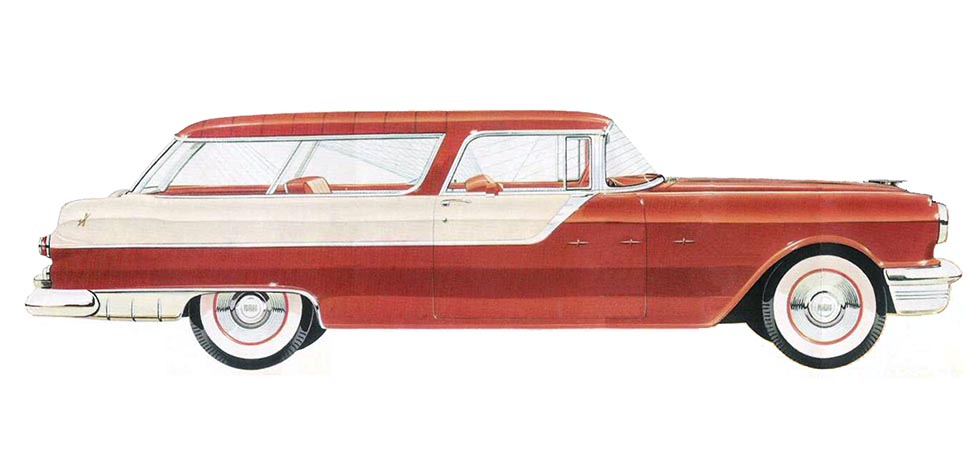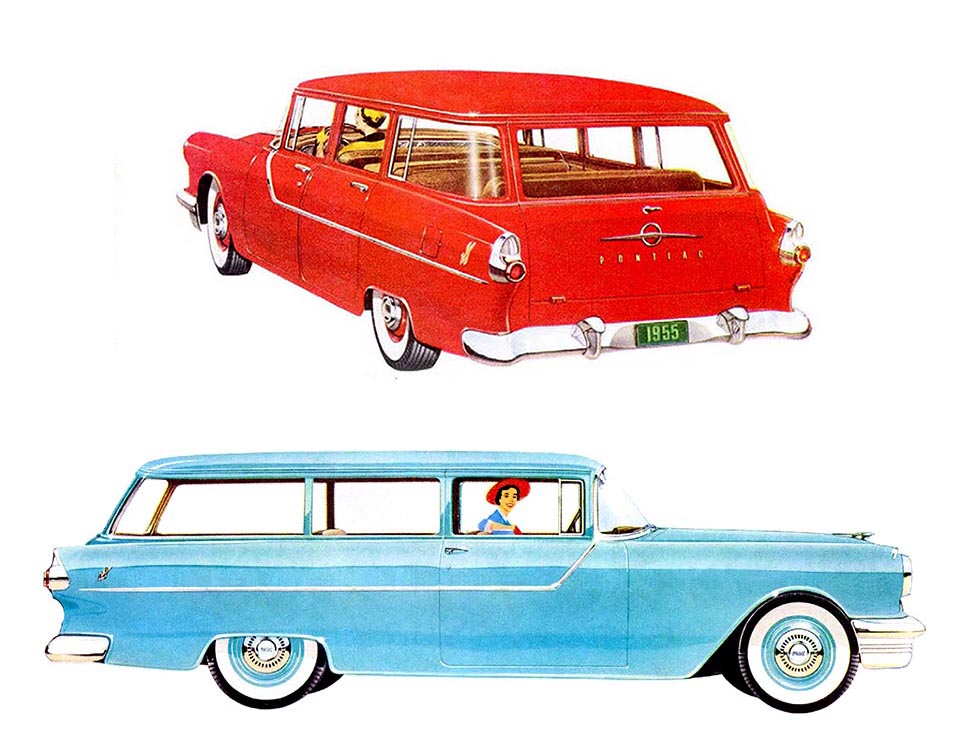General Year Information
A completely new body and chassis were developed for all 1955 Pontiacs. Changes from 1954 included a massive, divided bumper grille, revised body moldings, split ‘Silver Streak’ bands, twin streaks atop rear fenders, swept-style front wheel cutouts, and wraparound windshields.
A new 287 CID V-8 was introduced – changing Pontiac for al future generations of the big Indian. For the first time, all Pontiacs were overhead valve V-8 -powered — the L-Head I-6 and I-8 cylinder engines were retired.
Body style 2764DF, the two-door Custom Safari station wagon, was announced on January 31, 1955. The Safari featured two-door hardtop styling. It had a slanted tailgate, roof that was grooved side-to-side, Star Chief rear fenders and luxury interior appointments.
Chieftain station wagons for 1955 utilized Chevrolet station wagon rear fender styling. Model 860 4-door sedans had distinctive rear ventipanes. The two-door Chieftain station wagon, was sometimes referred to as the “Colony” wagon.
Model year production peaked at 554,106 full-sized units, an increase of 266,362 – almost double 1954 production.
Chassis Information
- Wheelbase: Series 27 – 122″, Series 28 – 124″.
- Overall length: Series 27 passenger cars – 203.2″, Series 27 station wagons – 202.9″, Series 28 210.2″.
- Front tread: (All) 58.66″.
- Rear tread: (All) 59.05″.
- Tires: (passenger cars) 7.10 x 15; (station wagons 7.60 x 15, tubeless type. NOTE: 7.60 x 15 tires were recommended for Star Chiefs.
Models Offered
860/870/STATION WAGON LINE – SERIES 27
There were three series of Chieftains in this Series, along with the Custom Safari, a wagon with two-door hardtop styling and Star Chief trim and appointments, but on the Chieftain 122-inch chassis. Except for the Safari that had tapered slanting vertical slash moldings, Chieftains featured a narow, constant width slanting vertical slash molding.
Chieftain 860s had small hub caps, painted taillight housings. and no upper belt line moldings. 860 vehicles featured only sedans and wagons, there were no hardtops in this line. Interiors featured nylon weave seating surfaces and Morrokide upper trim.
Chieftain 870s had full wheel discs, chrome taillight rings, and upper belt line trim. The line offered a wagon, a two-door and four-door sedan and a “Catalina” 2-door hardtop. Interiors were much more plush than the 860 Series, with cloth, nylon and Morrokide trims.
STAR CHIEF LINE – SERIES 28
1955 Star Chiefs also shared the completely new GM A-Body styling of the lesser series, however with an 11-inch rear frame extension. All models featured tapered slanting vertical slash moldings, (which were also used on the Series 27 two-door Star Chief Custom Safari).
Engines
Engine Options and Availability
- Options and availability listed in the “Engines” tabs above
Power Train Options
- A three-speed manual gear box with column mounted gear shift was standard on all models.
- Dual-Range Hydra-Matic drive was a $178 extra cost option.
- Available for $35, after March 1955, was the V-8 “Power Pack” option.
- A variety of rear axle gear ratios was available.
Body Paint Color Codes
Other Significant Options
- 4-Way manual seat ($40).
- Air-conditioning.
- Artic windshield wipers.
- Autronic Eye.
- Comfort-Control Heater.
- Dash panel courtesy lamps.
- DeLuxe steering wheel for Special station wagons.
- Directional signals.
- Door edge guards.
- Door handle guards.
- Electric antenna.
- Electric window lifts.
- Fender skirts ($11).
- Glove box lamp.
- Grille bug screen.
- Lighted ash tray.
- Padded dashboard.
- Power brakes ($36).
- Power steering ($108).
- Power windows ($97).
- Radio.
- Rear seat speaker.
- Reduced ratio power steering.
- Remote control outside mirrors.
- Safety spot lamp.
- Trunk lamp.
- Under hood lamp.
- Visor vanity mirror.
- Windshield washers.
- Wood grained Di-Noc trim not available for station wagons.

















